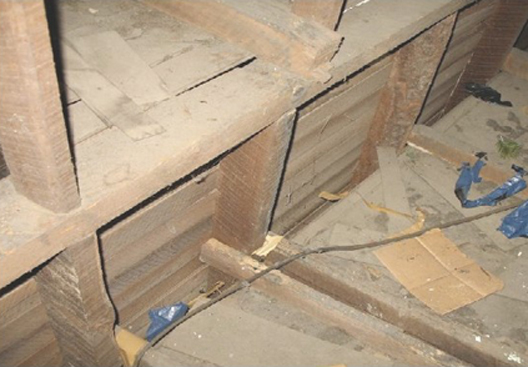
Image Credit: All photos: Pure Energy Coach
Image Credit: All photos: Pure Energy Coach This air handler has an unsealed return-air plenum. When the blower is operating, the leaky return plenum pulls attic air into the duct system. Weatherization contractors and home performance contractors call this kind of big hole a "bypass." Test smoke isn't going up the chimney, indicating weak draft pressure. The pressure boundary is re-established by capping this dropped soffit hole with rigid foam board and canned spray foam. Once the air sealing work has been completed, insulation will be blown over the whole area.
It’s important to keep attic air out of the house and house air out of the attic. That’s why the home performance industry and every above-code building program make it a top priority to fully separate attics from the rest of the building.
When the attic isn’t fully air sealed from the living space and the combustion appliance zone, three undesirable scenarios can occur:
- Attic air may contain contaminants, including mouse droppings, fiberglass, asbestos, and mold. If this contaminated air gets sucked into the living space, it can cause health problems for the occupants.
- Air from the living space below can carry water vapor into the attic, hitting a cold place in the attic and causing rot and mold growth.
- Leaks of conditioned air from the home into an attic waste energy.
The stack effect
How does air from the living space get into the attic?
In the winter, when the heat is on, heated air rises and expands and pushes against the top ceiling of the building. If there is a way for the air to get into the attic, it will.
Air leaks out at places where the builder didn’t seal, such as around the tops of walls near the ceiling (through and around leaky top plates), around attic hatches, through dropped soffits above cabinets, around recessed lights, and around chimneys.
As air leaves the building through these cracks, air also gets sucked out of the basement, typically around the chimney chase.
This air movement due to the stack effect is the biggest reason for heat loss in the winter.
An open wall top
Image #1 (at the top of the page) shows an open wall top — that is, a partition wall without a top plate. Heated air from the living space gets into this wall and rises into the attic.
This wall also delivers moisture to the attic, which can lead to roof rot and mold. And the leaking air can suck on the combustion appliance zone (the area of the house where the furnace and water heater are located), causing these appliances to backdraft.
In some cases, cold attic air can drop into the living space through these openings, leading to frozen pipes.
Return air ducts with leaky seams
How does air from the attic get into the living space? As mentioned above, it cold attic air can fall down open chases, especially when the house is depressurized by exhaust fans.
If there are ducts in the attic and the return ducts have holes in them, attic air can also be sucked into the house through those duct leaks. See Image #2 (below), which shows an unsealed return plenum in an attic.
Anything that causes unbalanced room air pressures can cause bad air from the attic to mix with good air in the house.
The stack effect can depressurize your basement
Can an unsealed attic cause the combustion appliance to backdraft? Yes, when a bypass (such as a chimney chase) isn’t sealed in the attic, the stack effect can suck air out of the basement.
Since most of our heating appliances and water heaters are in basements, their flue pipes can be the source of the make-up air that is being sucked out the basement.
This is very dangerous! For more information on this issue, watch our YouTube video on Zonal Pressure Diagnostics.
Recommendations from the Building Performance Institute
What does the Building Performance Institute (BPI) say about attic air sealing? BPI standards are very clear about this issue, providing the following recommendations:
- Don’t add attic ventilation without first verifying that the attic is fully air sealed from the rest of the building. Adding attic ventilation without ensuring that there is a solid air barrier between the attic and the living space will make air and heat from the house leak out faster, because the attic will be colder in the winter and the rate at which air leaves the building will increase.
- If the house air entering the attic is carrying moisture with it, the moisture may condense on the cold roof deck and cause wood rot and maybe mold.
- Unbalanced house pressures can cause natural draft heaters and water heaters to backdraft fumes. The fumes may contain carbon monoxide (CO). CO is very dangerous and can cause death.
Test methods
BPI expects technicians to verify an effective air barrier between the living spaces and the attic spaces by doing visual inspections and by using a blower door to perform zone pressure testing with a manometer and smoke.
An infrared camera can also be a very effective way to find remaining air leaks.
The benefits of having a complete air barrier between attic spaces and the rest of the building are:
- Reduced air flow, so the house is less drafty and people are more comfortable.
- Lower energy use.
- Reduced chance of mold and roof rot.
- Pollutants in the attic stay in the attic and don’t enter the living space.
- Reduced air suction on the combustion appliance zone, so natural draft combustion appliances have a better chance of drafting properly and carrying fumes outside instead of backdrafting. Pollutants in flue gasses (including CO) stay in the flue and chimney and don’t enter the house.
- An air barrier allows the attic to be insulated and ventilated.
- An air barrier keeps moisture in the basement or crawl space where it can be controlled by dehumidification (or, in some climates, by ventilation).
A. Tamasin Sterner is president of Pure Energy Coach in Lancaster, Pennsylvania and The Pure Energy Center in Montana. She has worked in the energy efficiency and energy conservation field for over 30 years. Tamasin is a nationally recognized expert in energy efficiency. She was selected to advise President Obama on the proposed federal Home Star program.
Weekly Newsletter
Get building science and energy efficiency advice, plus special offers, in your inbox.





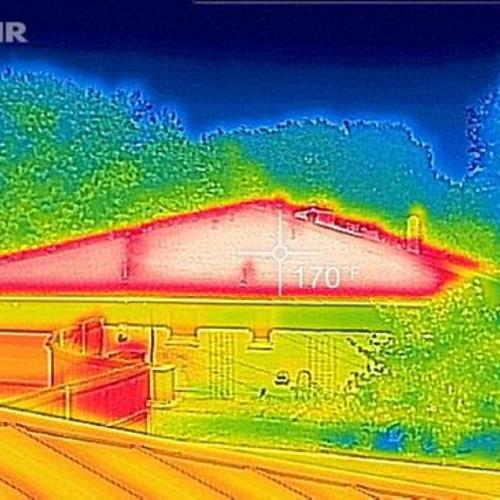
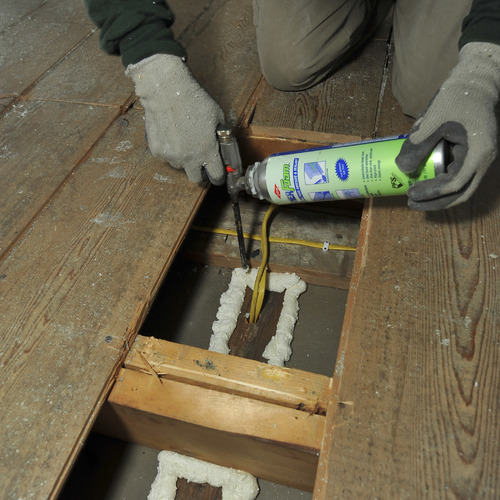
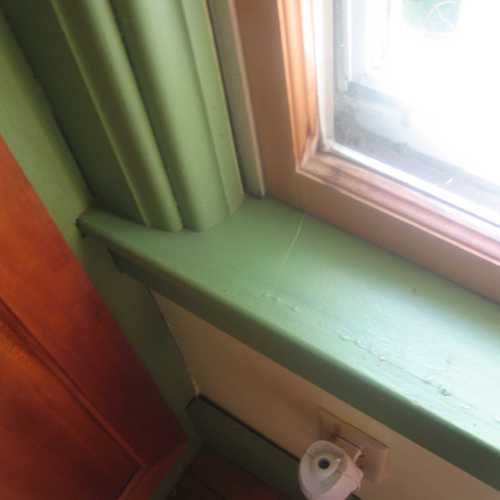
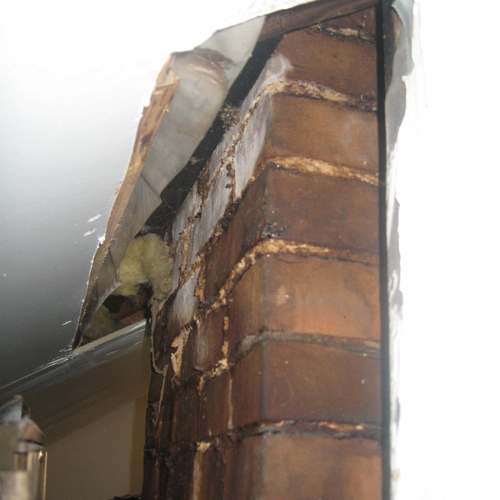






7 Comments
what a world
Experts: if I looked up experts in my own dictionary I'd find someone like Elon Musk not somebody that knows you have to seal the attic ceiling plane to stop air moving into the attic.
If this blog contains expert information then there are quite a few experts here at GBA... just sayin folks seems to be quite a bit of PhD and expert tossed around this joint.
GBA is a great source of information for residential building.still, I will always get a chuckle at how often you toss PhD in and expert at us.
Your best non PhD experts are Martin Dana and your architects that do they're great Audio blog and those that are helping us understand mini splits and how good they are and the PGHers!
Go PGH!
Tamasin...if I read this blog without the resume fluffernutter I would not have been so hard, I apologize. it's a good blog for the totally uninformed.
Response to AJ
AJ,
I have no idea why you feel the need to question whether A. Tamasin Sterner is an expert.
Is it because the intent of the article is to provide useful information to homeowners who are considering an energy audit? If so, that seems a strange reason to disparage her expertise.
I certainly hope that your attitude is not based on gender prejudice.
Martin,
One has to realize that the comments made by AJ BUILDER are stated so because he is the self-proclaimed "curmudgeon" of GBA. If one follows all his comments a certain underlying theme begins to emerge. That theme is that he is very sarcastic and somewhat brash. Maybe he can't help it but I would take it with a grain of salt because this isn't his first such response to something he doesn't like.
true true and true
Look... The info is darn lightweight. After all my years I'm an expert at spotting fluff.
Nothing to do with gender... How the heck did my heckle come off that way. Actually the blogger blogged well... I am making fun of the italic follow-up bragging the credentials....
Someday we'll ask,"how many PhDs does it take to lower one's ACH?...."
Bunches apparently!
Hey, it's fun Thursday.... Give serious life a break and laugh with me... It's as good for you as this expert advice is it not!?
:!)
Way to(o) hot to post less seditiously
Aj (expert curmudgeon by unpopular vote)
More detail on pressures and air movement
I wouldn't dispute the importance of a good air barrier between the attic and the living space, nor do I doubt the existence of the stack effect. I am having some difficulty putting together some of the different statements in this article with the forces and air flows described.
In the second paragraph of the Stack Effect section, we are told that in the winter, "heated air rises and expands and pushes against the top ceiling of the building." This is in harmony with the usual description of the stack effect, which diagrams the upper half of a house as having positive pressure, while the lower half has negative pressure. The next paragraph of this section says that as a result, air "gets sucked out of the basement". So we have air moving from a low pressure area to a high pressure area. Do not pass Go, Do not collect 200 references to the laws of thermodynamics. When this is happening, I'd like to read a more complete and complex description of the pressures and air flows, in order to explain and help me understand how this seemingly impossible event is the natural resort of actual conditions.
Within a few hours of the article appearing on GBA, Allison Bailes III posted an article on Pascal's Principle, which presents certain contradictions to the explanation presented here. I'm hoping that additional information will make it clear how the two articles can coexist.
Response to Derek
A better explanation would be due to the low air pressure in the basement cold outside air gets sucked in. As it is heated by the building's heating system and energy flows it then rises. This heated rising air causes the air pressure at the upper part of the house to increase, which causes the warm inside air to get pushed out of the house. In this case the net movement of air is from low pressure to high pressure, this is because you are adding energy to a system which is affected by buoyancy. ie less dense air sits on top of more dense air. Air pressure is separate so you counter intuitively have higher pressures in the less dense portion of the air column (because you are adding energy to the system, once you stop adding energy the air pressures will normalize). The air movement inside the building is driven (in this case) by the density differences, not the pressure differences.
Response to Derek Roff
The stack effect is an amazing phenomenon. It's not so much for the physics behind it, although that's certainly interesting, as the discussion that it engenders whenever it comes up. I wrote about the stack effect a while back, and the comments just poured in. That also was what inspired my article about Building Science Fight Club.
Anyway, Tamasin is correct about air moving from the bottom of the house to the top of the house, even though that seems to violate the rule of air moving from higher pressure to lower pressure. In fact, it doesn't violate that rule at all, because the negative pressure she was talking about at the bottom of the house and the positive pressure at the top both refer to pressures relative to outdoor pressure.
See the diagram below I've attached from an article by Joe Lstiburek on the Building Science Corporation website. (Click for a larger version.) Those two diagonal lines on the right side (solid for outdoor air and dotted for indoor air) show that the absolute (barometric) pressure increases as you go down. (The horizontal scale is pressure. The vertical scale is height.)
Thus, the air inside the house has higher pressure at the bottom than at the top. With holes at the top and bottom, the air can flow, and the higher pressure air at the bottom pushes the air above it upward. The even higher pressure air outdoors at the bottom of the building is what pushes the lower indoor air up.
If you're wondering why all the air at ground level doesn't just flow upward because it's at a higher pressure than the air above it, the answer is gravity. Everything can be stable because the lower, higher pressure air is also pulled down more strongly by the Earth's gravity. Of course, in the atmosphere, things don't stay stable for long, as our changing weather patterns show us every day.
Log in or create an account to post a comment.
Sign up Log in